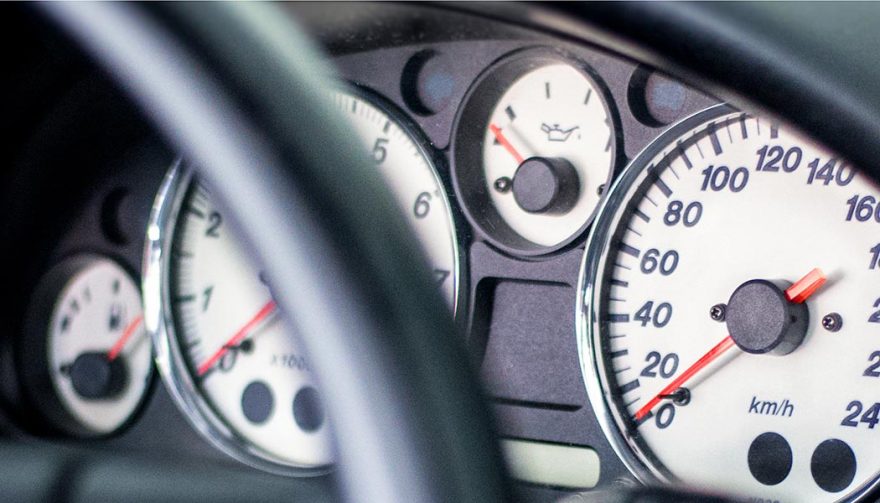
Dahboard gauges do malfunction, and fixing them is usually beyond the scope of a home technician
How to Troubleshoot a Fluctuating Oil Pressure Gauge
What to Do When Your Oil Pressure Gauge Fluctuates While Driving
So your oil pressure gauge fluctuates while driving? People instinctively do not believe dash gauges. When the fuel gauge shows empty, we know there is a few more miles left in the tank. So, what should you do when the oil gauge fluctuates while driving?
The oil gauge is different. If something is wrong with the engine, it can mean a greater problem than looking for the nearest gas station. Let’s follow a logical trouble-shooting procedure to figure out why your oil pressure gauge fluctuates while driving.
Check Your Oil Level First
Cars do get low on engine oil, especially now that we no longer have full-service gas stations to check it for us. Some cars do not hold much oil to begin with, so as little as 1 quart (or so) low can make the gauge reading erratic. Top it off.
Contrary to popular thinking, using an engine oil that is too thin will not make the gauge reading erratic on an engine that is in good mechanical condition. If installing a thicker viscosity oil raises the oil pressure, then something major is wrong inside the engine. Besides, modern cars are designed to use very thin oil anyway.
Gauge Problem vs. Oil Pressure Problem
Dashboard gauges do occasionally go bad, but it is very rare. Repairing a dashboard or gauge is usually beyond the scope of DIY car maintenance. The gauge does receive its data from a simple sending unit on the engine and those sending units do go bad quite frequently. So, how do you determine which one is at fault, the gauge or its sender?
You can buy an inexpensive universal oil pressure gauge from an auto parts store. Locate the oil pressure sending unit on the engine (the parts store can sometimes tell you where it is), remove it and follow the instructions that come with your universal oil pressure gauge to hook it up. Then, drive the car and see what the gauge does. Be careful to watch the road as you do this. Don’t become fixated on watching the gauge.
If the oil pressure is good and reads stable, replace the sending unit and drive the car again to verify your repair. A bad sending unit will usually also show signs of leaking engine oil.
When is the Reading Erratic?
Many repairs have been done unnecessarily because the repair shops did not get accurate information from the customer. Miscommunications do happen.
Is the Reading Low Only on Starting Up?
So, the first few seconds after starting the engine the gauge reads very low. It’s probably accompanied by some loud ticking noises from inside the engine. Then, the gauge suddenly shoots upward to normal and the ticking noise stops.
You have the wrong oil filter installed. Many engines require their oil filter to have an anti-drain back valve that prevents oil from draining downward, away from critical engine components when the engine is not running.
If the valve is absent, the oil supply passages inside the engine lose their oil. It will take a few seconds for the oil pump to fill the supply passages back up after the engine starts. Expect that problem to be worse in the mornings, after the car sits overnight. Install the correct oil filter and the problem should be fixed. Simple.
Is the Reading Low All the Time?
That’s serious, especially of it is accompanied by loud knocking noises from inside the engine. The engine will soon be ruined if it is not severely damaged already.
Don’t drive the car. Have it towed to a repair shop and properly diagnosed. Maybe you can catch a problem before it becomes too big to fix.
Does the Reading Fluctuate While Driving at a Steady Speed?
Okay, so you topped up the oil with the right viscosity, and for good luck, added an extra quart. It seemed to make sense at the time, adding the one extra quart.
Now the high oil level inside the crankcase is letting the crankshaft dip into it and whip the oil into a foam. That’s what happens when you put too much oil in your car.
Foam will not supply oil pressure, so the gauge reading will be erratic. You have to drain out the excess oil and hopefully that problem will be fixed.
It’s Still Not Fixed?
There are rare mechanical problems that can cause an unsteady oil pressure reading. They usually happen right after an engine has been overhauled.
If that sounds like you, then suspect a faulty oil pressure by-pass valve or spring inside the oil pump. Valves stick or can get installed wrong on some engines. Springs can be left out by accident.
What else can go wrong with a newly overhauled engine? Sometimes a machine shop can accidentally leave out an oil passage galley plug, causing a major loss of oil pressure. Think of it as an internal bypass leak — a big one.
Problems You Don’t Want to Have
Anything else is usually serious. A bad head gasket can let coolant leak into the crankcase, which will dilute the oil into foam. It will show up on the dipstick as a real mess.
But you might get lucky with that. A leaking intake manifold gasket is actually quite common on some engines and will cause the same symptom: coolant in the engine oil. Typically, though, you will find factory service bulletins on that issue by doing a simple online search. Intake gaskets are much easier to replace than head gaskets.
Has the Engine Been Poorly Maintained?
Let’s say that you can see heavy sludge buildup inside the oil filter or inside a valve cover. This is not good. That same sludge can accumulate on the oil filter pick up screen, starving the oil pump for oil flow. That will cause an erratic gauge reading, but it usually ruins the engine too.
If not, then you can remove the oil pan and replace the screen. Occasionally, we have had to remove the valve covers and the intake manifold as well and scrape all that sludge out of the engine. It’s a messy job. Why remove the sludge?
Because engine oil has a detergent additive in it. That detergent can loosen accumulated sludge and put it into circulation inside the engine, where it can cause all kinds of damage, like anther clogged up oil pickup screen. Now you know.





